Day 2 – Low Carb Breckenridge 2017
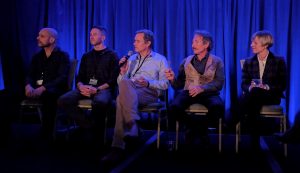 What a star studded day! Jason Fung, Eric Westman, Michael Eades, Zoe Harcombe, Ivor Cmmuns, Ted Naiman and Ron Rosedale. This is going to be a long one. Oh, and tomorrow they’ve blocked time for some of the lesser luminaries like myself to have their “5 minutes of fame” and address the whole conference and I’ve been given my 5. It all seems like a dream, I have to pinch myself frequently.
What a star studded day! Jason Fung, Eric Westman, Michael Eades, Zoe Harcombe, Ivor Cmmuns, Ted Naiman and Ron Rosedale. This is going to be a long one. Oh, and tomorrow they’ve blocked time for some of the lesser luminaries like myself to have their “5 minutes of fame” and address the whole conference and I’ve been given my 5. It all seems like a dream, I have to pinch myself frequently.
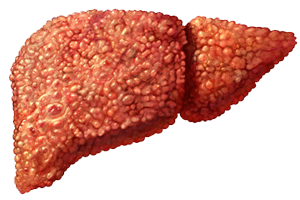 There was a lot of talk today about viceral fat deposited in the liver, pancreas and kidneys being the driver of the metabolic syndrome and type 2 diabetes which are really just 2 phases of the same process artificially divided. When fat is deposited in the liver it first causes Non-alcoholic Fatty Liver Disease (NAFLD) and when it gets more severe (again this is an arbitrary division of one continuous process) it is called Non-alchoholic Steatohepatitis (NASH). NASH can lead to eventual cirrhosis of the liver indistinguishable on autopsy from Alcoholic cirrhosis which can be fatal. Several presenters pointed out that 40% of adults and 30% of children in the US had enough fat in their liver to qualify as having NAFLD. There was widespread agreement that this was caused by excess carbohydrate consumption, especially sugar, with the fructose sugar being the worst offender. I’ll mention each presenter’s Particular take on it as we discuss each speaker.
There was a lot of talk today about viceral fat deposited in the liver, pancreas and kidneys being the driver of the metabolic syndrome and type 2 diabetes which are really just 2 phases of the same process artificially divided. When fat is deposited in the liver it first causes Non-alcoholic Fatty Liver Disease (NAFLD) and when it gets more severe (again this is an arbitrary division of one continuous process) it is called Non-alchoholic Steatohepatitis (NASH). NASH can lead to eventual cirrhosis of the liver indistinguishable on autopsy from Alcoholic cirrhosis which can be fatal. Several presenters pointed out that 40% of adults and 30% of children in the US had enough fat in their liver to qualify as having NAFLD. There was widespread agreement that this was caused by excess carbohydrate consumption, especially sugar, with the fructose sugar being the worst offender. I’ll mention each presenter’s Particular take on it as we discuss each speaker.
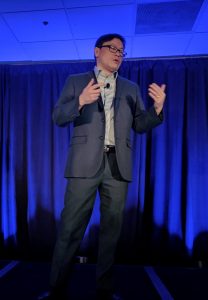 The first presenter was Dr. Mark Berger who is a radiologist. He talked about how to use medical imaging to diagnose NAFLD and NASH. He said the most inexpensive and non-invasive test was an ultrasound. He also recommended getting a DEXA-scan (Dual-energy X-ray absorptiometry) a type of x-ray if you had blood tests or obesity that might suggest you had early metabolic syndrome. The DEXA-scan will not only show if you have fatty liver but also if you just have the earliest stage, increased viceral fat. He pointed out that it is not uncommon for people who appear thin to have a lot of viceral fat. This is called TOFI (Thin on the Outside, Fat on the Inside) and requires urgent treatment as these people are at high risk of all the problems of the metabolic syndrome (Heart Attack, Stroke, Diabetes and Cancer to name a few).
The first presenter was Dr. Mark Berger who is a radiologist. He talked about how to use medical imaging to diagnose NAFLD and NASH. He said the most inexpensive and non-invasive test was an ultrasound. He also recommended getting a DEXA-scan (Dual-energy X-ray absorptiometry) a type of x-ray if you had blood tests or obesity that might suggest you had early metabolic syndrome. The DEXA-scan will not only show if you have fatty liver but also if you just have the earliest stage, increased viceral fat. He pointed out that it is not uncommon for people who appear thin to have a lot of viceral fat. This is called TOFI (Thin on the Outside, Fat on the Inside) and requires urgent treatment as these people are at high risk of all the problems of the metabolic syndrome (Heart Attack, Stroke, Diabetes and Cancer to name a few).
Then Dr. Jason Fung gave a lecture on how we get Diabetes and why a low carbohydrate, high fat diet is the only logical treatment for it. He cited many studies showing how effective a low carb diet could be and how well it worked in his practice. He agreed that the road that leads to diabetes starts with the over-consumption of carbs and sugar which leads to increased viceral fat and eventually full blown diabetes and is completely reversible with a low carbohydrate diet.
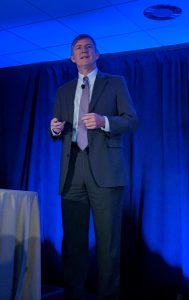 Next came Dr. Eric Westman of the Duke University Lifestyle Medicine Clinic who has treated 1000s of diabetics successfully in his clinic. I loved his opening line. He said the proverb about health should read “A slice of bacon a day keeps the doctor away”. As I mentioned in the Meet and Greet Blog post he is starting a business to train doctors in how to treat diabetics with low carb. He also mentioned having success using it for Polycystic Ovary Disease, and Lymphedema (leg and arm swelling due to obstruction of lymph vessels) among many other conditions. One issue that is always controversial is whether to count total carbs or “net carbs” (Total carbs minus the fiber content) he was very much on the side of total carbs. His analogy was that “Total Carbs” was the “Doctor Strength” version while “net carbs” was the “over the counter strength” and if you had the metabolic syndrome you wanted the best medicine. I wish him well with his campaign.
Next came Dr. Eric Westman of the Duke University Lifestyle Medicine Clinic who has treated 1000s of diabetics successfully in his clinic. I loved his opening line. He said the proverb about health should read “A slice of bacon a day keeps the doctor away”. As I mentioned in the Meet and Greet Blog post he is starting a business to train doctors in how to treat diabetics with low carb. He also mentioned having success using it for Polycystic Ovary Disease, and Lymphedema (leg and arm swelling due to obstruction of lymph vessels) among many other conditions. One issue that is always controversial is whether to count total carbs or “net carbs” (Total carbs minus the fiber content) he was very much on the side of total carbs. His analogy was that “Total Carbs” was the “Doctor Strength” version while “net carbs” was the “over the counter strength” and if you had the metabolic syndrome you wanted the best medicine. I wish him well with his campaign.
In the Q&A session Dr. Westman pointed out that there was no reason people who had had their gall bladder surgically removed could not eat a high fat diet as the bile duct to which the Gall Bladder has previously been attached merely enlarged to form a Gall Bladder substitute. Dr. Rosedale seconded this and Dr. Berger, a radiologist said he routine say the common duct, normally 6 mm, routinely expand to 10-20 mm for this purpose.
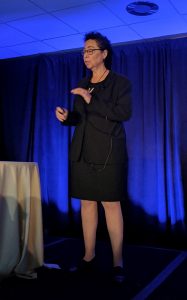 Dr. Dawn Lemanne is a highly knowledgeable Onchologist, researcher and professor with a focus in nutrition in the treatment of cancer. I learned a lot of interesting things that I didn’t know and truly enjoyed her presentation. She said not all cancers were associated with the metabolic syndrome. Breast, Colon and Endometrial cancers were the ones most associated with excessive carbohydrate consumption. Here are some of the other points she made
Dr. Dawn Lemanne is a highly knowledgeable Onchologist, researcher and professor with a focus in nutrition in the treatment of cancer. I learned a lot of interesting things that I didn’t know and truly enjoyed her presentation. She said not all cancers were associated with the metabolic syndrome. Breast, Colon and Endometrial cancers were the ones most associated with excessive carbohydrate consumption. Here are some of the other points she made
- taking insulin upped a person risk of developing cancer.
- a high LDL Cholesterol is protective against cancer. This was particularly interesting because many low carbe/keto folks and zero carbers, like me have fairly high LDL Cholesterol readings.
- in advanced colon cancer (stage 3-4) lowering carbs was more effective than chemotherapy if the person was fat (BMI >25)
- in breast cancer decreasing carbs by just 25 grams per day decreased recurrence by 27%
- a ketogenic diet had cured glioblastoma multiforme, an incurable brain tumor in mice, a tumor that had never been cured before with any treatment.
- she warned that the ketogenic diet could be bad in some tumors that had a BRAF V600E DNA mutation that allowed the tumors to burn fat, the most common of these being Hairy Cell Leukeina (almost 100%), Melanoma (50%), Colorectal cancer (10%), prostate cancer (10%) and Multiple Myeloma (5%)
- Radiation therapy is more effective in combination with a ketogenic diet because the radiation primarily kills dividing cells and ketones slow the rate of division among normal cells so less are killed.
- Intermittent fasting works better than prolonged fasting and slows cancer growth (but cannot cure it) and potentiates chemotherapy.
- Fasting alone can inhibit and even fully reverse Acute Leukocytic Leukemia.
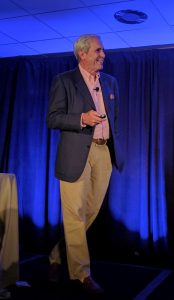
I really enjoyed her presentation and how much she cared about her patients came through loud and clear.
Next came Dr. Michael Eades who is close the heart of me and most Zero Carb eaters because he has said in several lectures and repeated to me today that he often feels best when he is eating only meat. Dr. Eades understands the Kreb’s cycle which we use to burn fat, glucose, ketones, amino acids and lactate in our mitochondria to produce energy as well as anyone on the planet in my opinion, certainly much better than I do. He explained in exquisite detail why we do not need to eat carbohydrate and how we can actually produce glucose from fat if we need to do so. The main point being that there is no requirement to eat a single carbohydrate in our diets.
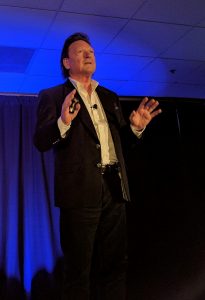 After Dr. Eades Came Dr. Nicholas Worm an Nutritionist from Germany. He is an expert on treating fatty liver disease. He explained that by labeling fat with radio isotopes they could tell that 59% of the fat in a fatty liver had originally been in the patient’s own fat cells. The way it got into the liver is that when the patient ate too many carbs they were turned into fat in the liver and shipped to fat cells. Fat cells can only expand to about 10 times their empty size without becoming inflamed and non-functional, leaking fat back into the blood stream which then eventually winds up in the vicera (Liver, pancreas and kidneys) to become Viceral fat and start the metabolic syndrome, eventually resulting in Diabetes and all its complications if carbohydrates continued to be consumed. He stated that the most effective treatment was limiting carbohydrate in the diet. In one study of carb restriction for 8 weeks the amount of fat in the liver decreased by 30% on average and cure was possible in a few months.
After Dr. Eades Came Dr. Nicholas Worm an Nutritionist from Germany. He is an expert on treating fatty liver disease. He explained that by labeling fat with radio isotopes they could tell that 59% of the fat in a fatty liver had originally been in the patient’s own fat cells. The way it got into the liver is that when the patient ate too many carbs they were turned into fat in the liver and shipped to fat cells. Fat cells can only expand to about 10 times their empty size without becoming inflamed and non-functional, leaking fat back into the blood stream which then eventually winds up in the vicera (Liver, pancreas and kidneys) to become Viceral fat and start the metabolic syndrome, eventually resulting in Diabetes and all its complications if carbohydrates continued to be consumed. He stated that the most effective treatment was limiting carbohydrate in the diet. In one study of carb restriction for 8 weeks the amount of fat in the liver decreased by 30% on average and cure was possible in a few months.
He also talked about how fat in the pancreas eventually caused enough inflammation that the beta cells were no longer able to produce enough insulin triggering the high blood sugars that meet the criteria for the diabetes diagnosis. This again was reversible when carbohydrate consumption markedly decreased. In the Q&A session Dr. Westman added that a study published in the journal “Cell” February 22nd had shown the rejuvenation of beta cells in Type 1 diabetics using short term fasting. Acquiring new functional beta cells had been considered impossible until now to my knowledge.
 After lunch Zoe Harcombe, a specialist in meta-analyses who did her PhD thesis on whether adequate evidence existed to support the dietary guidelines that were first introduced in the US in 1977. She meticulously reevaluated all the data available at the time and clearly showed that indeed, there was absolutely no substantial evidence on which to conclude that saturated fat was a causative factor in heart disease. She was widely attacked by the nutrition establishment who said that the evidence to support the guidelines did indeed now exist. So she broadened her investigation to include current evidence and did another meta-analysis and again found no causative association between saturated fat and heart disease. There had been 7 other meta-analyses on the subject, 2 of which had found a causative association. She reviewed these two and found gaping flaws and errors that if corrected negated the causative association that had been found. The low carb cause is so lucky to have this intelligent and tireless warrior on our side. Go Zoe!
After lunch Zoe Harcombe, a specialist in meta-analyses who did her PhD thesis on whether adequate evidence existed to support the dietary guidelines that were first introduced in the US in 1977. She meticulously reevaluated all the data available at the time and clearly showed that indeed, there was absolutely no substantial evidence on which to conclude that saturated fat was a causative factor in heart disease. She was widely attacked by the nutrition establishment who said that the evidence to support the guidelines did indeed now exist. So she broadened her investigation to include current evidence and did another meta-analysis and again found no causative association between saturated fat and heart disease. There had been 7 other meta-analyses on the subject, 2 of which had found a causative association. She reviewed these two and found gaping flaws and errors that if corrected negated the causative association that had been found. The low carb cause is so lucky to have this intelligent and tireless warrior on our side. Go Zoe!
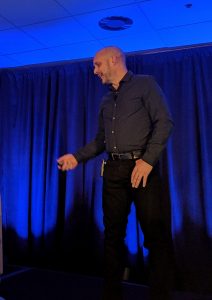 Then Ivor Cummins, a systems engineer who has applied his problem solving skills to understanding the metabolic syndrome or as I like to call it “carbohydrate poisoning” took the stage. He has interviewed some of the leading researchers in the country. He discussed the pathophysiology as well as any doctor. He made one point of which I was unaware. To understand you first have to realize that fatty liver leads to resistance to the actions of insulin and so ever more and more insulin is needed which leads to more fat production (unless you stop eating the carbs) and insulin turns out to be the instrument of a lot of the damage caused by the metabolic syndrome. Well, there have been a lot of “mouse studies” that claimed that fat was causing insulin release. He pointed out that eating fat by itself did not cause insulin release. Insulin release is driven by K Cells in the duodenum that release Gastric Inhibitory Protein (GIP) which signals the pancreas to release insulin. Only carbs and protein cause the K cells to release GIP. But in the presence of fat, K cells release a lot more GIP in response to carbs than they would have if the fat were not present. And in these mice studies that claimed that fat increased insulin there was also carbs in the food they were given.
Then Ivor Cummins, a systems engineer who has applied his problem solving skills to understanding the metabolic syndrome or as I like to call it “carbohydrate poisoning” took the stage. He has interviewed some of the leading researchers in the country. He discussed the pathophysiology as well as any doctor. He made one point of which I was unaware. To understand you first have to realize that fatty liver leads to resistance to the actions of insulin and so ever more and more insulin is needed which leads to more fat production (unless you stop eating the carbs) and insulin turns out to be the instrument of a lot of the damage caused by the metabolic syndrome. Well, there have been a lot of “mouse studies” that claimed that fat was causing insulin release. He pointed out that eating fat by itself did not cause insulin release. Insulin release is driven by K Cells in the duodenum that release Gastric Inhibitory Protein (GIP) which signals the pancreas to release insulin. Only carbs and protein cause the K cells to release GIP. But in the presence of fat, K cells release a lot more GIP in response to carbs than they would have if the fat were not present. And in these mice studies that claimed that fat increased insulin there was also carbs in the food they were given.
He spent a lot of time showing how the Coronary Calcium Score (CAC), a CT scan test that looks at the coronary arteries to see if calcifications that lead to heart attacks are present in the heart arteries. It is much more reliable that any blood test at predicting the development of heart disease. The good news he had to bring was that low carb diets had been shown to halt the normal increase that is usually seen year after year in most patients and that if that happened the heart attack risk return to the same risk as someone who had no Calcium seen on their CAC test which is very low (2.4%). He showed from several studies that included both LDL Cholesterol so beloved of cardiologists and the CAC score, that the CAC score was a much better predictor of heart disease.
 After Ivor came fellow Board Certified Famiy Medicine Physician, Dr. Ted Naiman who uses low carb and keto in his practice. He said that 70% of all deaths in the US were due to the metabolic syndrome (Carbohydrate Poisoning) through the mechanisms of Cancer, Heart Disease and Neurodegeneration (Alzheimers) with high insulin levels at the heart of all these diseases. One interesting fact I got from his talk is that most people are not able to grow new fat cells but about 10% of people are. These are the people that get to be 600-800 lbs. He said this is why how fat you can get before developing the metabolic syndrome is different for everyone. Some people can look thin but have tons of viceral fat and be diabetic because they just didn’t have that many subcutaneous fat cells. He called the level of fat storage where the metabolic syndrome began “the Personal Fat Threshold”.
After Ivor came fellow Board Certified Famiy Medicine Physician, Dr. Ted Naiman who uses low carb and keto in his practice. He said that 70% of all deaths in the US were due to the metabolic syndrome (Carbohydrate Poisoning) through the mechanisms of Cancer, Heart Disease and Neurodegeneration (Alzheimers) with high insulin levels at the heart of all these diseases. One interesting fact I got from his talk is that most people are not able to grow new fat cells but about 10% of people are. These are the people that get to be 600-800 lbs. He said this is why how fat you can get before developing the metabolic syndrome is different for everyone. Some people can look thin but have tons of viceral fat and be diabetic because they just didn’t have that many subcutaneous fat cells. He called the level of fat storage where the metabolic syndrome began “the Personal Fat Threshold”.
There is a test where they measure the ratio of oxygen to carbon dioxide you are breathing out which is called the Respiratory Quotient (RQ). It will be between 0.7 and 1.0. the closer it is to 0.7 the more you are using fat for fuel and the closer to 1.0 the more you are burning glucose and also the higher your risk of developing the metabolic syndrome. Much of what he said I have already documented from other presentations so I’ve edited them. He had a very detailed presentation on the metabolic syndrome and also discussed fatty liver. Another very enjoyable presentation
 John Schoonbee had a very interesting perspective on the economic ramifications of the low fat, high carb government guidelines. He works in the Insurance Industry and said that every year the insurance industry has to “guess” whether people’s life expectancy is going to increase due to improved health care in future years so they will live longer and pay in more money, before they can set the price for death and disability insurance. He stated that up until about 1980 the life expectancy had steadily improved and they had actually underestimated how much the longevity really went up. But starting in 1980 the slope of improvement started dropping of and this year for the first time went negative leaving the insurance industry with much lowered profits as people were not paying premiums as long as expected before collecting. What he thinks might work is for the official government guideline to change which would reverse this trend. He said something I agree with. He didn’t think anyone should be forced to eat a low carb diet, but that they should be aware of the data showing how much it could help them, then they could make an informed decision about whether they chose to eat a high carbohydrate diet or not which is not currently the case. He felt this would also benefit all governmental and private health insurance companies and every person on earth but that changing the guidelines was being resisted by the healthcare industry, the pharmaceutical industry, the diet industry, processed food manufacturers and pension funds who all stood to lose significant amounts of money were this to occur. I think he is right on.
John Schoonbee had a very interesting perspective on the economic ramifications of the low fat, high carb government guidelines. He works in the Insurance Industry and said that every year the insurance industry has to “guess” whether people’s life expectancy is going to increase due to improved health care in future years so they will live longer and pay in more money, before they can set the price for death and disability insurance. He stated that up until about 1980 the life expectancy had steadily improved and they had actually underestimated how much the longevity really went up. But starting in 1980 the slope of improvement started dropping of and this year for the first time went negative leaving the insurance industry with much lowered profits as people were not paying premiums as long as expected before collecting. What he thinks might work is for the official government guideline to change which would reverse this trend. He said something I agree with. He didn’t think anyone should be forced to eat a low carb diet, but that they should be aware of the data showing how much it could help them, then they could make an informed decision about whether they chose to eat a high carbohydrate diet or not which is not currently the case. He felt this would also benefit all governmental and private health insurance companies and every person on earth but that changing the guidelines was being resisted by the healthcare industry, the pharmaceutical industry, the diet industry, processed food manufacturers and pension funds who all stood to lose significant amounts of money were this to occur. I think he is right on.
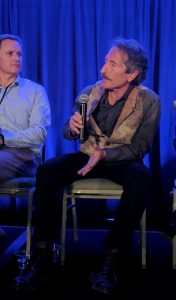 Dr. Ron Rosedale, clearly one of the elder pioneers in the low carb movement is doing final edits on a book on the mTOR system. He said just the first chapter was 160 pages and it needed a lot of editing but would be out this year. His special interest is longevity research and is a leading expert in one of the hottest avenues of longevity research, the mechanistic target of rapamycin (mTOR) system. This a very complicated hormonal control system present since the first primordial cell 500 million years ago that had a true nucleus (Eukaryocyte). mTOR is a hormone receptor located in mitochondria that controls many functions, but of special interest is that it is the central control for whether a cell decides to use it’s energy and nutritional resources to repair and replace cellular components or to save these resources for reproduction in which case the cell’s life and eventually the life of the body it resides in is shortened. Proteins are all made of amino acids and proteins which we eat are broken down in the gut and absorbed as amino acids. Amino acids are capable of binding to mTOR and raising it’s activity. The more amino acids bind to mTOR receptors the more the balance is pushed away from repair and replace activities in the cell. There are some good studies in animals to show that lowering dietary protein decreases mTOR stimulation leading to a longer life for the animals. Thus Dr. Rosedale feels that protein, especially in anyone older than 35 should be restricted to around 0.6 grams per kilogram lean body mass per day.
Dr. Ron Rosedale, clearly one of the elder pioneers in the low carb movement is doing final edits on a book on the mTOR system. He said just the first chapter was 160 pages and it needed a lot of editing but would be out this year. His special interest is longevity research and is a leading expert in one of the hottest avenues of longevity research, the mechanistic target of rapamycin (mTOR) system. This a very complicated hormonal control system present since the first primordial cell 500 million years ago that had a true nucleus (Eukaryocyte). mTOR is a hormone receptor located in mitochondria that controls many functions, but of special interest is that it is the central control for whether a cell decides to use it’s energy and nutritional resources to repair and replace cellular components or to save these resources for reproduction in which case the cell’s life and eventually the life of the body it resides in is shortened. Proteins are all made of amino acids and proteins which we eat are broken down in the gut and absorbed as amino acids. Amino acids are capable of binding to mTOR and raising it’s activity. The more amino acids bind to mTOR receptors the more the balance is pushed away from repair and replace activities in the cell. There are some good studies in animals to show that lowering dietary protein decreases mTOR stimulation leading to a longer life for the animals. Thus Dr. Rosedale feels that protein, especially in anyone older than 35 should be restricted to around 0.6 grams per kilogram lean body mass per day.
He made a couple of comments about mTOR that were particularly interesting:
- when justifying the low protein recommendation he pointed out that a breast feeding infant only gets 1 gram of protein per kg of body weight per day at a time when protein requirements are very high.
- mTOR is upregulated in 70% of malignant tumors
- mTOR controls whether fat or glucose is burned preferentially by the mitochondria
His presentation was much more elegant and detailed than mine. I have certainly moderated my protein since hearing him speak on this topic a couple of years ago and the evidence for the theory just keeps mounting. I can’t wait to read his book.
 Finally I got meet Dr. Gary Fettke of Australia, a true hero of the Low Carb Cause. He was tried by the Australian Medical Board in secret for giving low carb advice and enjoined never to give dietary advice again. This injustice is still rippling around Australia and hopefully soon legislation will reverse this miscarriage. I had the privilege of talking to him and lovely wife Belinda about it today and will continue to post update on my blog and Facebook as this ongoing battle unfolds.
Finally I got meet Dr. Gary Fettke of Australia, a true hero of the Low Carb Cause. He was tried by the Australian Medical Board in secret for giving low carb advice and enjoined never to give dietary advice again. This injustice is still rippling around Australia and hopefully soon legislation will reverse this miscarriage. I had the privilege of talking to him and lovely wife Belinda about it today and will continue to post update on my blog and Facebook as this ongoing battle unfolds.
Hope you enjoyed this. One more day to go. As I have to drive back to Albuquerque (8 hour drive) after the conference ends tomorrow, I doubt I will be able to get the day 3 summary out until Monday evening. I hope you’ll continue to join me for this fascinating and informative conference.
Thank you, mega mucho, for this synopsis !!!
Thank you for this very informative synopsis. And thank you for representing Carnivory later today.
Lovely updating, Paul, you are always clear, honest and a thinking mind.
That combined with your knowledge as medical doctor, your self-experimentation and your total capacity to read through the chatter, look at science through your own eyes, with an unbiased approach. Thanks for your wonderful work. keep it on. 🙂
Thanks, Romi
Paul, as always thanks for the effort to keep your interested borntoeatmeat.com blog followers up to date – your comments are almost as good as being there…NOT!
Really appreciate how you laser in on one real good point every presenter is making – that takes a focus considering the amount of information coming at you in one day.
Rosedale’s recommendation on protein per K. of ideal lean body mass at 0.6 has me already recalculating my steak/bacon or even egg quota. YIKES!
Thanks
awesome!
When you take your 5 minutes of fame,knock’em dead! You deserve the opportunity after 100+lb. weight loss. I suspect being ardently ZC, your views on plant consumption may prompt interest from the keto crowd.Good luck.
I really like your blog.. very nice colors & theme. Did you create this website yourself or did you hire someone to do it for you? Plz answer back as I’m looking to construct my own blog and would like to know where u got this from. thanks a lot
I use a custom WordPress Theme called “Elegant Themess – DiVi” It’s pretty easy to use. https://www.elegantthemes.com/